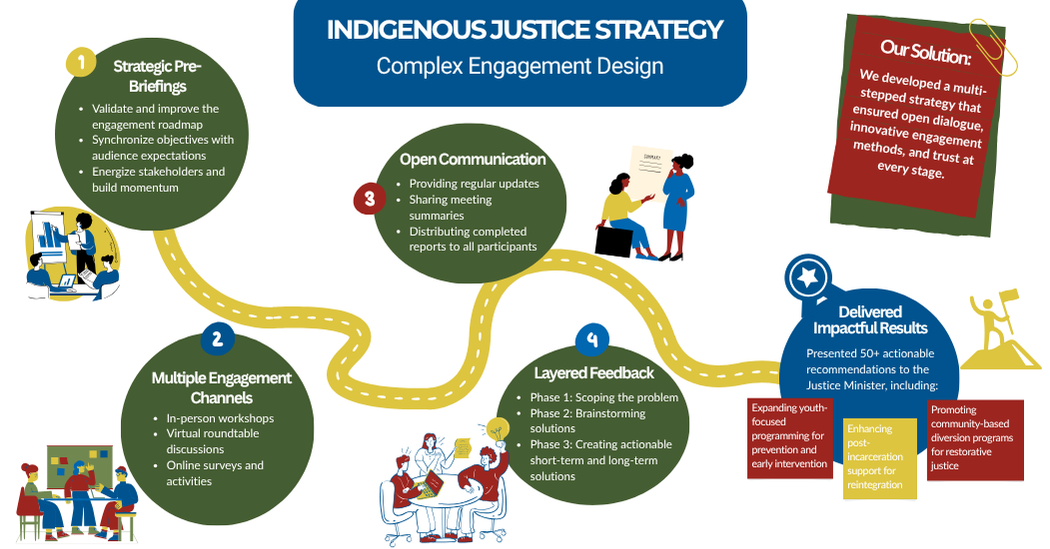Justice Canada engaged KES to partner on the multi-year, highly complex development of the Indigenous Justice Strategy (IJS). had There were two main goals related to the development of the Indigenous Justice Strategy (IJS) for Canada:
• Reduce over-representation of Indigenous people in the Canadian justice system
• Eliminate the systemic racism that Indigenous people face in the Canadian justice system
In driving this innovative transformation, KES was faced with many obstacles including:
• The huge number of perspectives and voices that needed to be included in the conversation, including First Nations, Metis, Inuit, frontline workers, corrections officers, people with lived experience, victims, members of the judiciary, and representatives from provincial and territorial governments
• Balancing the immediate needs of communities in crisis with long-term, sustainable solutions that will take time to implement
• Engaging with populations that have been asked to participate in numerous dialogues on similar topics in recent years, leading to engagement fatigue, apathy, and a lack of trust
• Prioritizing underheard narratives and perspectives, including currently incarcerated persons, unhoused persons, and people with disabilities.

To drive results in this complex project, we delivered a carefully crafted, multi-stepped strategy that ensured open dialogue, innovative engagement methods, and trust at every stage.
Strategic Pre-Briefings
KES was a trail blazer for Pre-Briefings. Pre-Briefings are early alignment sessions that set the stage for success by:
o Validating and improving our roadmap,
o synchronizing objectives with audience expectations and needs, and
o energizing stakeholders and building momentum for impactful formal dialogues.
Multiple Channels of Engagement
Given the huge anticipated audience and wide variety of accessibility and engagement needs, our strategy included many ways to participate in the engagement including in-person workshops, virtual roundtable discussions, and online surveys and activities
Layered Feedback Mechanism
A dynamic, wave-based feedback system powered iterative improvements to the IJS engagement. Over successive rounds of dialogues, we moved moving from:
o scoping the problem to
o brainstorming solutions to
o the creation of actionable and concrete short term and long-term solutions
Open and Ongoing Communication:
Over the two years that the IJS engagement took place, the KES team ensured that all participants and interested parties received regular updates regarding the status of the project, summaries of all meetings they took part in, and copies of all reports completed throughout the project. This helped foster trust and demonstrate ongoing progress.
Delivered over 50 actionable recommendations to the Justice Minister, addressing key priorities such as:
Expanding youth-focused programming to emphasize prevention and early intervention.
Enhancing post-incarceration support systems to facilitate smoother transitions and reintegration into society.
Promoting community-based diversion programs to reduce reliance on punitive measures and foster restorative justice.
This comprehensive approach ensured that the voices of Indigenous peoples from coast to coast to coast co-created every recommendation, building a robust foundation for transformative justice initiatives.

KES pioneered a two-eyed seeing approach for the Indigenous Justice Strategy, blending Indigenous ways of knowing with our public engagement expertise. For this project, we needed to balance long-term strategic innovation with short-term, immediate intervention to uplift both current and future generations. In particular, we:
Engaged partners early to shape and validate a strategy that would be meaningful to Indigenous partners and address their key areas of interests
Crafted discussion topics that encouraged story-sharing and personal insights alongside policy dialogues
Applied our 7 Generations methodology to ensure multi-generational perspectives on IJS goals, prioritizing a better future while grounding solutions in traditional approaches to justice and community safety. This led to a number of key dialogues with youth and elders throughout the project
Visited corrections facilities and spoke first-hand to people with lived experience to better capture the obstacles and challenges they are facing
© KES 2023 | All Rights Reserved